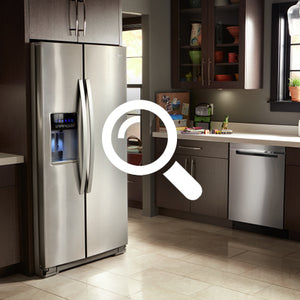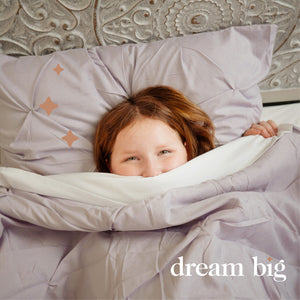Choosing the correct laundry pair can help you save time and money. Today’s laundry machines are much more efficient and provide a variety of features and choices. This buying guide will help you identify those features and options to help you make your buying decision.
Laundry & Washing Machine Buying Guide
LAUNDRY BUYING GUIDE
INTRODUCTION
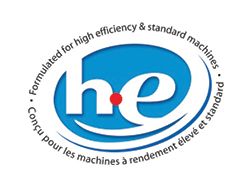
WASHING MACHINES
WHAT IS HIGH EFFICIENCY (AND DO I NEED IT)?
The traditional automatic washer, also known as an “agitator” washer, is a Regular Efficiency washer that has been around since the 1970s. It has a top-load design where laundry is totally submerged in water and the agitator (or impeller) moves back and forth vigorously to loosen dirt from clothing.
In the 1990s, the High Efficiency (HE) washer came into the marketplace. It utilizes a “tumbling” mechanical process, much like a dryer, using paddles to lift and drop clothes into the water as it cleans. This results in less wear and damage to the clothes. Due to its design, HE washers use 20% to 60% of the water used in the agitator washer. This results in significant energy savings of 50% to 70% as there is much less water to heat. Washing capacity also increased with HE washers as there is no agitator in the middle of the drum, allowing you to wash sleeping bags and other large articles. Another benefit is that the HE washer drum spins a lot faster compared to the agitator washer (1400 RPM vs. 1100 RPM) ) removing excess water, and resulting in faster drying times – which subsequently ends up taking less time and energy from your dryer.
Because of the low-water wash and rinse cycles of HE washers, it is important to use detergents specially designed for HE washers that are low-sudsing and quick dispersing. Using detergents designed for regular washers can produce excess suds which causes “cushioning” that prevents the tumbling action, thus impacting proper cleaning.
WASHERS
When we talk about type of washer, we are not talking about colour or finish, but how your washer is engineered. There are 3 main types of washers – Top Load Regular Efficiency, Top Load High Efficiency, and Front Load High Efficiency.
TOP LOAD REGULAR EFFICIENCY
These are the traditional, agitator models that require you to fill the machine with water to the top of the washtub twice (once for washing and once again for the rinse cycle), resulting in a high volume/use of water.
Key benefits of this type of machine are that you can load and unload it from a standing position which results in less bending and no kneeling. Another handy feature is that you can easily add any items after the cycle has started without interrupting the cycle by simply opening the lid and throwing them in. Perhaps the biggest benefit is the size and price. They are generally smaller than HE units which can be an advantage in small spaces, and due to their old technology, regular efficiency models have a lower purchase price than HE units.
TOP LOAD HIGH EFFICIENCY (HE)
Top load HE washers combine the best features of both the Top Load regular efficiency model and the Front Load HE model.
Like the Top Load Regular Efficiency, it allows you to load and unload from a standing position, resulting in less bending and kneeling. Like the Front Load HE, it has the same benefits of water and energy savings along with its non-agitator design. Top Load HE models also have higher capacity tubs than Top Load regular efficiency and tend to be less expensive than Front Load HE models, offering the best value.
Last but not least, as with Top Load Regular Efficiency models, you can easily add items after the cycle has begun by simply opening the lid and throwing them in.
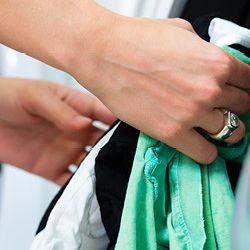
FRONT LOAD HIGH EFFICIENCY (HE)
Front load HE washers have made dramatic changes to how machines are engineered as well as how we now wash clothes. Front load washers are designed with the washtub turned on its side. Along with its technological advances of drum load sensors, it can automatically judge how much water is required to wash the load, using substantially less water than a regular efficiency top load.
Key benefits of this type of machine are the energy savings in both water and electricity. By using less water and having faster spinning drums, clothes dry a lot faster in the washer and also later in the dryer. Due to its non-agitator design, clothing is handled in a gentler fashion which makes items last longer and allows for more capacity. Control panels for front-loads are front and center allowing for easier access.
Front load washers tend to have the highest price points, on average, out of the three types of washers.

OPTIONS & FEATURES
PAIRS
Should I replace my laundry pair if only one piece needs replacing?
There are several advantages to purchasing a laundry pair besides aesthetic reasons.
If you keep the old dryer but replace the washer, with a higher capacity and larger wash loads, you will need to wait at times as your dryer will not be able to dry the wash load in one dryer load. Conversely, if you keep the old washer but purchase a higher capacity dryer, you are not using the dryer to its full potential and wasting energy as a result.
By purchasing a “matched pair”, there is no guesswork as to the size of the loads between the two machines – they are designed to work together.
In effect, Drying time = Wash time. How much is your time worth?
Another benefit of buying a pair is that they are typically priced cheaper than buying each unit individually.
WHICH WASHER FEATURES WOULD BE IMPORTANT TO ME?
There are several features offered on today’s washers that you may not be familiar with. Let’s take a look at some of the available features and functions:
Capacity is measured in cubic feet (cu. ft.) Lower capacity washers start at the 2.2 cu. ft. size compared to larger HE washers that can handle 6.4 cu. ft. Why is capacity important? Consider multiple loads. You can do 1 load instead of 2 with a larger capacity washer – thus saving you time.
Heavy loads - Do you wash a lot of work clothes, sport uniforms, towels, etc.? Can your present washer handle it effectively? You may want to consider a higher capacity unit with a stainless steel drum and heavy-duty motor.
Steam (wash and dry) - You can use steam technology that penetrates fabrics to remove dirt in the washer cycle and remove wrinkles, odours, static and allergens in the dryer cycle. These features can replace dry cleaning and save you money. To take advantage of this feature, you will need to have a water line near your washer and dryer.
Soil and stain removal features - There are several cycle features you can use to tackle stains. For those emergency stains that you need to take care of right away, the Speed Wash cycle can be used to quickly rinse a soiled article. For those stains that have set and need extra power, the Stain Wash Cycle can handle the toughest stains.There are several features offered on today’s washers that you may not be familiar with. Let’s take a look at some of the available features and functions:
Sensors - There are a number of sensors used in the operation of your HE washer. Based on load size, the washer can identify how much water is required to wash the load. As well, moisture sensors in a dryer can determine how dry the garments are to stop cycles at the appropriate time.
Safety features - Child lock controls and automatic shut off are important safety features for a busy family household.
Spin cycles - HE washers spin at a faster RPM which removes excess water, resulting in faster drying times.
DRYERS
WHICH DRYER FEATURES WOULD BE IMPORTANT TO ME?
There are 2 types of dryers available – Gas and Electric. Both types use an electric motor to tumble the clothes and an electric fan to distribute the heated air. The main difference between the two is the energy source used to heat the dryer.
Gas dryers have the advantage using a cheaper fuel source although their initial cost is slightly higher than an electric model. One major consideration when choosing gas is whether there is a natural gas line in your laundry area. You will need a professional gas fitter to install a line if one doesn’t currently exist. Another consideration is having a 110/120V plug nearby to power the electric motor and fan. Gas dryers also require a new gas connector to be purchased as old ones should not be reused.
Electric dryers require twice the strength of an ordinary house current to operate. There are two types of power cords that have been used for 220/240V connections. Older dryers have been using a 3-prong plug while all new dryers now use a 4-prong plug. You will need to purchase a power cord with your new dryer as they do not come with one.
VENTILATION
Both gas and electric dryers require external venting, meaning there’s a rigid or semi-rigid metal tube running from your dryer to outside the house. This is especially imperative for gas dryers where there is risk of carbon monoxide poisoning if not vented properly. Most new dryers require the purchase of a new vent kit which includes a metal tube, corner pieces and clamps.
In the event that it is not possible to properly vent your dryer outside, some manufactures offer a vent-less condensation dryer. These models use a heat exchanger which then cools and condenses the heat to a water vapor instead of sending it through an exhaust vent.
LINT TRAYS
What is lint? It’s the residual fabric fibers from your clothes that break off from the friction of wear and tear. In the washing phase, lint is extracted and remains on the garment in its wet state and then dries in the drying phase. The lint then is blown and trapped into a lint screen for later removal. Over time, lint is built up, both on the lint screen and the venting tube causing a blockage of air and potential overheating. In extreme cases, fires have known to start as a result. In 2010, 32% of dryer fires reported in the U.S. were caused by a “failure to clean”.
Look for dryers that have the following features regarding lint control:
- Top Mount Lint Vent – Easier to access and clean compared to in-drum models
- Vent Blocking indicator – This lets you know when to clean the vent and/or lint trap
DRYING CYCLES
Today’s dryers can offer up to 14 different cycle selections. Which ones do you need? All you need to do is select the cycle and the dryer does the rest. Let’s take a look at some of the available key features and functions:
Antibacterial/Sanitation - A sanitation cycle eliminates up to 99.9% of common household bacteria and germs that find their way into clothing. A dryer with a sanitizing cycle uses high heat to sanitize items that can’t be easily washed. This can provide relief to family members that may have allergies.
Delicate cycles use a very low temperature to gently dry specialty garments like silk and loosely woven fabrics.
Eco-Cycle/eDry - The “Eco” cycle can be named differently by different manufactures but it essentially saves energy by accurately monitoring the dryness of clothes and adjusts the heat used by extending the cycle time.
Moisture Sensors - Located in the drum, moisture sensors monitor the moisture level of your laundry. They sense when the garments reach your preference of damp or completely dry, and trigger the cycle to stop. This prevents over-drying which extends the life of your garments.
Rack Dry - Certain items like a hat, stuffed animals or footwear may be damaged during the cycle when the drum is tumbling. When a rack accessory is snapped into place, the items remain stationary on the rack while the drum tumbles.
Steam - During this heated cycle, short bursts of steam are sprayed onto the dry garments. This helps remove wrinkles, odours and reduce static. Some models allow you to adjust the degree of periodic tumbling to keep wrinkles from forming based on the number of garments in the dryer.
Other Specialty Cycles - Other cycles may be available to handle heavy or bulky items like jeans or sleeping bags, allow for delayed starts or many other drying situations. Each cycle is pre-programmed which removes the guesswork on time and temperature settings.
SPATIAL CONSIDERATIONS
Conserving Space – If space is at a premium in your household and side-by-side installation is not practical, you have other options available. Several front load washers allow you to stack the dryer on top of it by adding an optional stacking kit. This allows the same capacity with a smaller floor footprint. Depending on the dryer model, you may find controls more difficult to reach in the elevated positon.
Laundry Centers are a one-piece tower including top-load washer with dryer unit stacked on top of it. They are ideal for smaller spaces like apartments or closets. Due to its smaller size, capacity is reduced compared to full-sized units.
Another convenient option that is available is the Washer-Dryer Combo. This is an all-in-one unit which does both washing and drying (but not at the same time) in one appliance. This is a great solution if saving space is critical. One drawback is the extended load times as you will have to wait for one operation to finish before you can start another.
Pedestals - How about putting your Front-Load appliance on a pedestal? Tired of bending over and getting on your knees when you load and unload your Front-Load washer or dryer? Laundry pedestals are available with most appliances and designed to be the same width and depth of your appliances (which are also colour compatible). It will raise your appliance 15” which brings it to about chest level, saving strain on your back. The pedestal doubles as a storage unit, allowing you to conveniently store your laundry accessories.

INSTALLATION
There are a number of considerations about installing your laundry pair.
Location & Dimensions – Like other appliances, knowing where you will be placing your appliance can determine the size of appliance that will fit in your home. Will your laundry pair be down in the basement, main floor or second floor? You will need to measure the height, width and depth of the opening of where your laundry appliance will be located. You will need to allow for proper ventilation with a space of 1” to 3” on either side and in between the washer and dryer. Additional depth of 4” to 6” beyond the depth of the appliance is required to allow for water hookups, electrical cords, venting and gas lines. Is there enough height clearance if you want to add a pedestal or vertically stack front-load appliances? If the appliance is placed below an existing shelf, is there enough room to physically install it and will there be enough room for opening the washer and dryer doors?
Next, when the appliances are being delivered, is there enough clearance from the outside doorway to the resting location to maneuver through stairs, doorways and hallways? Planning your path and anticipating obstacles can save you time and frustration.
Utilities and Hook Ups – Laundry appliances can require planning and involvement with all three utilities. For gas dryers, you want to ensure you have the proper lines and hookups in place before delivery. For electric dryers, you will require a 220/240V receptacle and plug. For both types of dryers, you will need to ensure you have adequate venting. For washers and steam capable dryers, you will require adequate water connections and hoses.In the event that it is not possible to properly vent your dryer outside, some manufactures offer a vent-less condensation dryer. These models use a heat exchanger which then cools and condenses the heat to a water vapor instead of sending it through an exhaust vent.
Who will install? How will you get your new appliances home? Will you pick it up or will you have it delivered? Delivery generally does not include installation so it is important to have a plan for this. When your new product is delivered you will need to ensure that your old one is already disconnected from both power and water. Your sales person should be able to recommend installation options if this is not something you can complete yourself.
STAIN MANAGEMENT
What type of stains are there and how do I go about cleaning these stains?
Let’s look at the following list to find out more.
PROTEINS
OILS
TANNINS
DYES
COMBINATIONS
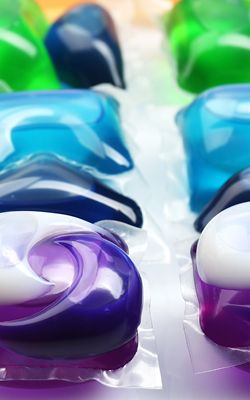
LAUNDRY SOAP COMPONENTS
Let’s look at the components that make up Laundry Soap:
ENZYMES
SURFACE AGENTS
WHITENERS
SOFTENERS
FRAGRANCES & COLOURING
FILLERS
Cleaning Tablets
Over time, odours and mildew can build up inside your washer. Washer cleaning tablets are designed to prevent odour-causing residue and keep your washer smelling fresh. Just add one tablet during every hot-water cycle.
LAUNDRY SOAP PRODUCTS
POWDER
| New Column | New Column |
| Pros
| Cons
|
LIQUID DETERGENT
| New Column | New Column |
| Pros
| Cons
|
HIGH EFFICIENCY
| New Column | New Column |
| Pros
| Cons
|



